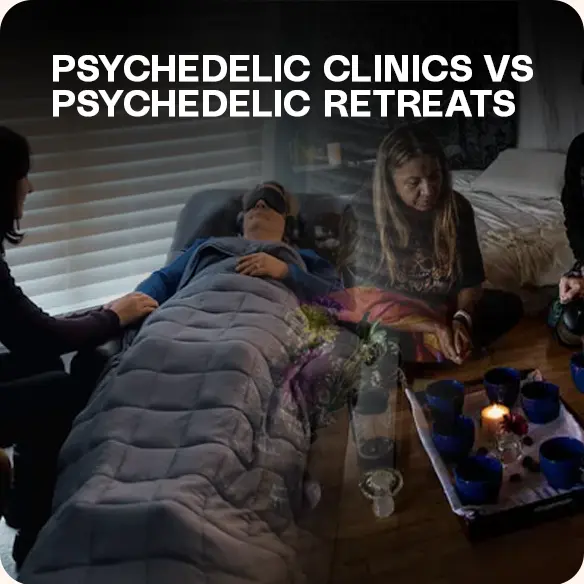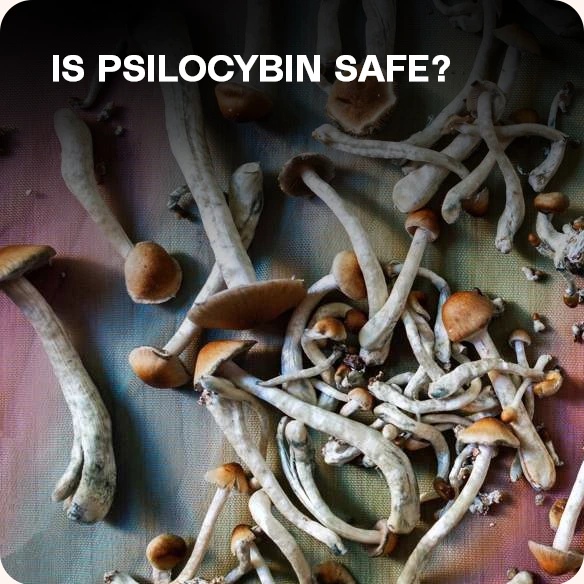Key Takeaways:
- Somatic healing is about focusing on your body to work through stress and emotions.
- It can help lower stress, improve mood, and even help with physical pain.
- Mixing somatic healing with microdosing psilocybin might help you feel more connected and aware of your emotions.
What is Somatic Healing and How Does it Work?

Somatic healing is a way to help your body and mind feel better by paying attention to how you feel physically. Sometimes, when we go through something hard or stressful, our bodies hold onto those feelings, and somatic healing helps us let them go.
Here’s how it works: You focus on your breathing, how your body feels, and where you might notice discomfort. A therapist might guide you through these steps or ask you to move around, stretch, or even do something gentle to help you relax.
By doing this, your body can release tension and stress you didn’t even realize was there, helping you feel calmer and more at peace. It’s like giving your body a chance to tell its story and feel better.
Also, check out our blog on what is psilocybin therapy?
What Somatic Healing Can Help With
Somatic therapy can be helpful for many different issues, both mental and physical. It’s a great option if you want to try something other than just talking about your feelings.
Here are some things it can help with:
Mental health issues:
- PTSD: Helps you work through trauma by connecting with your body.
- Anxiety: Calms your body to reduce anxious feelings.
- Addiction: Helps you understand and manage the physical and emotional triggers.
- Grief: Lets you release the heavy feelings stored in your body.
- Depression: Encourages emotional release through body awareness.
- Stress: Eases tension and stress by focusing on how your body feels.
Physical health issues:
- Chronic pain: Helps release tension that might be causing long-lasting pain.
- Digestive disorders: Reduces stress, which can help improve digestion.
- Sexual dysfunction: Encourages body awareness and healing.
Somatic therapy focuses on grounding and mindfulness, which is a great way to connect more with yourself and understand what you’re going through.
How Does Somatic Healing and Psilocybin Work Together?
Somatic healing and psilocybin work together by helping you become more aware of your body and emotions. Psilocybin makes it easier to connect with your feelings, while somatic healing helps you release those emotions through your body.
Together, they help you heal from tough experiences,making it easier to
understand yourself and feel better emotionally.
For more tips,
check out our blog on how psilocybin rewires our brain.
Enhanced Awareness
When you mix somatic healing with psilocybin, it helps you become more aware of what’s going on inside you.
This combination helps you stay calm and mindful while allowing you to discover new things about yourself. You might notice feelings or emotions you didn’t realize were there, and by working through them, you start to feel better.
Some of the benefits include:
- Handling emotions better: You learn to stay calm and manage your feelings.
- Solving personal challenges: You find new ways to work through tough problems.
- Improving relationships: You get along better with others because you understand yourself more.
Together, these practices help you grow, heal, and feel more happy with yourself.
Access to Subconscious Material
Psilocybin helps you find feelings and memories that are hiding deep inside. These might be feelings you didn’t know were there, and in combination with somatic healing, it makes it easier to notice them and feel better.
Here’s how it works:
- Pay attention to your body: Noticing how your body feels helps you find emotions you didn’t realize you had.
- Be in the moment: Staying focused on the present helps you connect with these hidden feelings.
- Feel safe: Being in a place where you feel safe makes it easier to open up and share your feelings.
By finding and understanding these hidden feelings, you can feel better and start to heal both inside and out.
Release of Trauma
When you combine somatic healing with psilocybin, it helps you let go of old hurts and feelings that have been stuck for a long time. This makes it easier to heal from traumas.
Here’s how it works. People pay attention to how their bodies feel when they think about emotional pain. During sessions, they do things like breathing exercises and notice where their body feels tense. This helps them understand where the pain is hiding.
As their minds become more aware, they often feel a strong connection to their bodies. This connection makes it easier to find old memories and feelings they may have buried deep inside. By facing these emotions, they can finally let them go.
People often feel a huge sense of relief after releasing these feelings. It helps them heal, feel stronger, and understand themselves better.
What Are the Different Types of Somatic Healing?

There are different ways to do somatic healing, each helping you connect your mind and body in its own special way. Some of these include:
Somatic Experiencing
This method teaches you how to release the stress and feelings your body has been holding onto because of a tough experience. By doing this, you don’t just feel better right now—you can heal the deep feelings causing the stress.
But how do you do this?
- Find a safe and comfortable space: You’ll sit or lie down in a relaxed position.
- Tune into your body: Focus on how your body feels. Notice any tightness, discomfort, or strange sensations.
- Gently talk about the trauma: With the help of a therapist, you’ll slowly think about or talk about the trauma, just enough to feel how your body reacts.
- Notice your body’s response: Pay attention to how your body reacts—racing heart, tension, etc.—which shows where your body holds the stress.
- Release the tension: You might be guided to move or stretch to help your body let go of that tension.
- Feel grounded: After releasing the tension, you’ll focus on feeling calm and safe.
The goal is to help you feel safe in your body again and give you control over your own healing journey.
Body Psychotherapy
Sometimes, when you’re feeling sad, angry, or stressed, you can feel it in your body, like tightness or a funny feeling in your stomach. This method helps you understand those feelings and let them go.
But how do you do this?
- Breathing exercises: Help you calm down and let go of feelings that are stuck inside.
- Moving your body: Helps you show your emotions by moving, like stretching or shaking, to feel better.
- Imagining: You picture your feelings in your mind, which helps you understand them and feel more in control.
These steps help you feel better inside, both emotionally and physically, so you can feel happier and calmer.
Mind-Body Therapy
Mind-body therapy is special because it helps connect how you feel physically with how you feel emotionally.
But how is this different from other somatic therapies?
- Mindfulness meditation: Helps you notice and accept your emotions without judgment. It’s learning to be okay with how you feel.
- Yoga: Combines stretching and movement to help release emotions stored in your body, while also making you more flexible.
- Guided imagery: Encourages you to picture positive things in your mind, helping you feel better emotionally.
What makes mind-body therapy unique is that it uses a variety of methods to help you connect your mind and body. By practicing these techniques, you become more aware of your emotions and physical sensations, which helps you handle stress and feel more balanced.
Read more about our blog on the best magic mushroom gummies.
How Can Someone Start Somatic Healing?
Starting somatic healing is easy, and you can do it right at home with small steps that help you connect with your body and emotions.
Here’s how you can begin:
- Start with mindfulness: Take a few minutes each day to sit quietly and focus on your breathing. Try deep breathing or guided meditation to help you notice how your body feels and process any emotions.
- Gentle movement: Practice yoga, stretching, or even tai chi. These movements help release tension in your body and keep you grounded in the present moment.
- Journal your feelings: After doing mindfulness or movement, write down how you feel. This helps you reflect on your emotions and understand yourself better.
- Practice conscious eating: Pay attention to what you eat and how it makes you feel. Being aware of your body during meals strengthens the connection between your body and emotions.
By adding these simple activities into your daily routine, you can start to feel more connected to yourself, improve your emotional health, and experience greater mindfulness.
How Does Somatic Healing Differ From Other Therapies?
Somatic healing differs from other therapies, like traditional talk therapy, because it focuses on the body first to help with emotional healing. Instead of only talking about your thoughts and feelings, somatic therapy helps you focus on what your body tells you.
In talk therapies like CBT (Cognitive Behavioral Therapy), the focus is on changing how you think. You work to recognize and change upsetting thoughts or behaviors, but it’s mostly about what’s happening in your mind.
With somatic healing, the goal is to feel safe in your body. You start by noticing physical sensations, like tightness or tension, and learn how to release them. This helps you heal from trauma by addressing the stress stored in your body, not just your thoughts.
Even mindfulness meditation, which helps you notice emotions without judging them, is different. Mindfulness lets any thought or feeling come in, but somatic therapy focuses specifically on how your body feels and responds to those emotions.
In short, while other therapies work with your mind, somatic healing starts with your body, helping you feel better by releasing the tension stored inside.
Conclusion
Somatic healing is a special way to help you feel better by paying attention to your body. Instead of just talking about your thoughts and feelings like in other therapies, this one helps you notice how your body feels.
By doing this, you can let go of any stress or tough emotions that are stuck inside. It helps you understand your feelings better and feel calmer.
Whether you’re feeling worried or sad or just want to feel more connected to yourself, somatic healing is a great way to help your body and mind work together.
Find out more in our recent blog, do microdosing capsules expire?
Frequently Asked Questions
What is Somatic Healing?
Somatic healing is a holistic approach that focuses on the mind-body connection to promote overall health and wellness.
How does somatic healing work?
Somatic healing works by helping people become more aware of their bodies and sensations, leading to insight into emotions and thoughts and the release of tension and trauma stored in the body.
What are the benefits of somatic healing?
Some of the benefits are stress reduction, improved emotional regulation, and better physical health.
How do Psilocybin and somatics complement each other?
When combined with somatic practices like yoga or breathwork, psilocybin can help people access deeper levels of consciousness and promote healing.
Is somatic healing a substitute for traditional therapy?
No, somatic healing is not a replacement for traditional therapy; it’s meant to complement the healing process, especially for those who have struggled with traditional talk therapy alone.
Can anyone benefit from somatic healing?
Yes, somatic healing is beneficial for people of all ages and backgrounds, especially for those who have experienced trauma, deal with chronic pain or stress, and those looking to improve their overall well-being.




